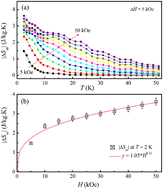Investigating the magnetic and magnetocaloric behaviors of LiSm(PO3)4
Abstract
We report a detailed study on the magnetic behaviors and magnetocaloric (MC) effect of a single crystal of lithium samarium tetraphosphate, LiSm(PO3)4. The analyses of temperature-dependent magnetization data have revealed magnetic ordering established with decreasing temperature below Tp, where Tp is the minimum of a dM/dT vs. T curve and varies as a linear function of the applied field H. The Curie temperature has been extrapolated from Tp(H) data, as H → 0, to be about 0.51 K. The establishment of magnetic-ordering causes a substantial change in the heat capacity Cp. Above Tp, the crystal exhibits paramagnetic behavior. Using the Curie–Weiss (CW) law and Arrott plots, we have found the crystal to have a CW temperature θCW ≈ −36 K, and short-range magnetic order associated with a coexistence of antiferromagnetic and ferromagnetic interactions ascribed to the couplings of magnetic dipoles and octupoles at the Γ7 and Γ8 states. An assessment of the MC effect has shown increases in value of the absolute magnetic-entropy change (|ΔSm|) and adiabatic-temperature change (ΔTad) when lowering the temperature to 2 K, and increasing the magnetic-field H magnitude. Around 2 K, the maximum value of |ΔSm| is about 3.6 J kg−1 K−1 for the field H = 50 kOe, and ΔTad is about 5.8 K for H = 20 kOe, with the relative cooling power (RCP) of ∼82.5 J kg−1. In spite of a low MC effect in comparison to Li(Gd,Tb,Ho)(PO3)4, the absence of magnetic hysteresis reflects that LiSm(PO3)4 is also a candidate for low-temperature MC applications below 25 K.



 Please wait while we load your content...
Please wait while we load your content...